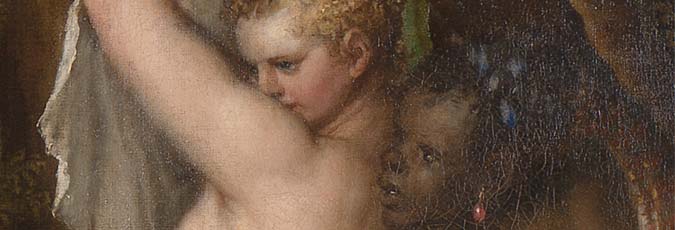Temporary exhibitions
Another hugely significant initiative to promote the viewing of Old Masters was the founding of the British Institution for Promoting the Fine Arts in the United Kingdom (1805-67). Its original object was ‘to encourage and reward the talents of the artists of the UK, and to open an exhibition for the sale of their productions’.
Its particular brand of exhibition was somewhat different from the displays organised at Stafford Gallery/Bridgewater House - rather than being an exhibition hosted in a private mansion and comprising pictures from just one collection, the British Institution organised its annual exhibitions at the Shakespeare Gallery in Pall Mall, a building specifically bought for the purpose of bringing together pictures lent by many different people.
The management fell to a group of gentlemen and aristocrats, some of whom were also on the committee of subscribers in charge of arranging the works within the exhibitions. Notably, the Marquis of Stafford was a founding member of the British Institution, and he went on to become its Deputy-President and Director for a decade from 1810 and then President between 1820 and 1825.39
The first exhibitions – which took place annually from the spring of 1806 – were solely of contemporary British art, giving a spur to British artists (especially those outside the protection of the Royal Academy) through offering them an additional selling space as well as more direct patronage in terms of premiums and commissions. Certainly artists profited from this initiative with many works of art being bought from the first and subsequent exhibitions. Notably, the Marquis of Stafford bought 15 works from the British Institution over the years, including Opie’s 'Belisarius', Westall’s 'Christ appearing to Mary Magdalen', and 'St Peter' by Shee.40 The Duke of Bridgewater himself had previously commissioned from J.M.W. Turner his painting of 'Dutch Boards in a Gale', but his nephew was a far greater patron.41
It did not take the British Institution any time, however, to get involved with exhibiting Old Masters. This initiative started after the close of the first exhibition of modern pictures, when the gallery was re-hung with a small but choice collection of Flemish and Dutch Old Masters which students and artists were permitted to copy undisturbed.42 These pictures had been borrowed from the most important private collections, including those of the Prince Regent, the Dukes of Bedford, Marlborough and Grafton, the Marquis of Stafford, the Earl of Grosvenor, Sir Abraham Hume, Sir George Beaumont and John Julius Angerstein.
The success of this first show led to the establishment of a summer exhibition of Old Masters, a tradition which continued until the institution’s demise in 1867, outliving the original spring exhibitions of living native artists’ work. Lords Stafford and Ellesmere lent a range of family pictures over the years, including the two Diana scenes in July 1839. The school of copyists, the original designated beneficiary of these exhibitions, proved immensely popular, which is not surprising given the high quality of the pictures available. But the influence of these loan exhibitions of Old Masters, being the first of their kind ever to be held in England, was felt more widely still and their progeny continue to flourish worldwide today.
A second temporary exhibition of huge importance was 'Art Treasures of the United Kingdom' which opened at Old Trafford, near Manchester on 5 May 1857. It deserves notice here because the Earl of Ellesmere, Queen Victoria’s representative in Lancashire and the principal local supporter of the enterprise, was the first chairman of its Executive Committee – at least from 1856 until his death in February 1857. The exhibition is usefully seen as a follow-on of the work of the British Institution, only it was much larger in size and scope as well as more ambitious in terms of its scholarly input and its attempts to educate the public.43
Thus the French critic Theopile Thoré felt able to suggest that the assembled collection was 'about on the level of the Louvre. The Spanish school, the German, Flemish and Dutch schools are even richer and more splendid. The English school can be seen only there. Only as regards the great Italians of the Renaissance does the Louvre surpass Manchester'.44 It is interesting to note that, according to one contemporary commentator, had Lord Ellesmere not died unexpectedly a few months before the exhibition was due to open, he would have boosted that Italian Renaissance section through the loan of his Orléans Collection Raphaels and Titians.45
Next: Permanent art galleries

